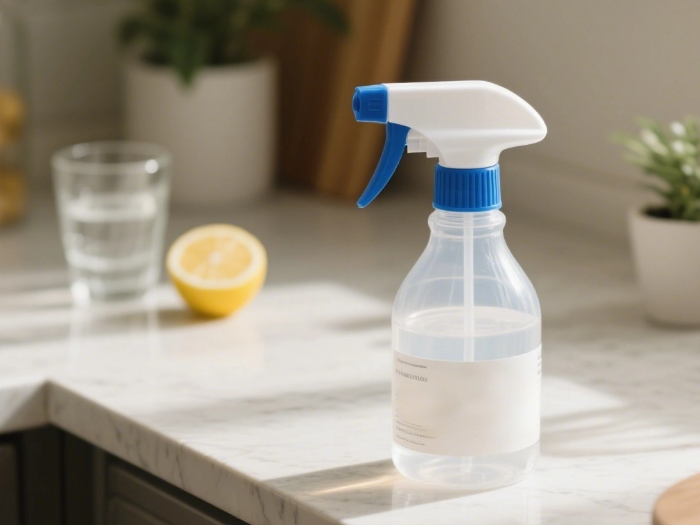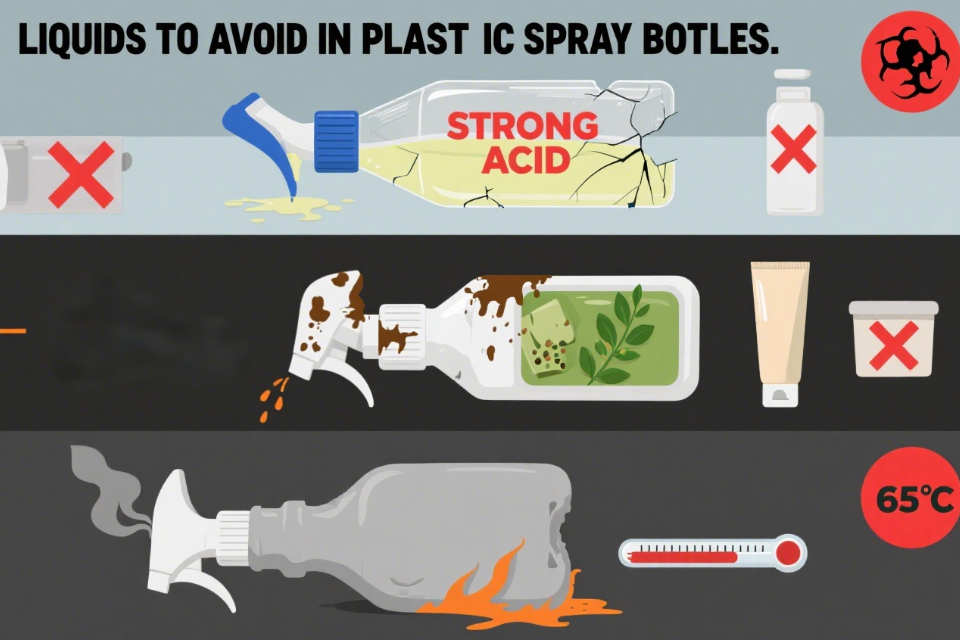Views: 28 Author: Site Editor Publish Time: 2025-09-28 Origin: Site












Plastic portable spray bottles—widely used as travel pocket spray bottles, or refillable sprayers for skincare and household use—are favored for their light weight, shatter resistance, and affordability. But many users worry: "Are they safe?" The answer depends on the plastic material (PET, PP, PE are the most common) and the liquid they hold. This article breaks down the safety of plastic portable spray bottles, compares PET/PP/PE materials, and provides a clear liquid compatibility list to help you use them safely.
Plastic portable spray bottles are safe when choosing the right material and using them correctly. The main safety concerns—chemical leaching (e.g., BPA, phthalates) and material degradation—can be avoided by focusing on two points:
Choose Food/Cosmetic-Grade Plastics: Reputable brands use plastics labeled "food-grade" or "cosmetic-grade," which are free of harmful substances like BPA, phthalates, and heavy metals. Avoid unlabeled, cheap plastic bottles (often made of low-grade materials that leach chemicals when exposed to heat or certain liquids).
Match Material to Liquid: Different plastics have varying chemical resistance. Using a plastic bottle incompatible with its liquid (e.g., strong acids in PET) can cause material degradation and leaching. For example, a PP spray bottle is safe for vinegar, but a PET bottle may degrade over time with acidic liquids.
PET (polyethylene terephthalate), PP (polypropylene), and PE (polyethylene, including HDPE and LDPE) are the three most common plastics for portable spray bottles. Their differences directly affect safety and usability:
Safety Traits: BPA-free (by nature, as it doesn’t require BPA in production), non-toxic, and has low chemical leaching risk. However, it’s less resistant to high temperatures (softens at 60-70°C/140-158°F) and strong acids/alkalis.
Physical Features: Transparent (easy to see liquid levels), lightweight (a 100ml PET bottle weighs ~15-20g), and moderately rigid—ideal for travel pocket spray bottles or fine mist bottles that need to be compact.
Best For: Short-term storage of low-viscosity, neutral liquids (e.g., water-based facial mists, alcohol-free toners, plain water). It’s not suitable for long-term use with acidic liquids (vinegar, citrus juices) or high-temperature environments (car dashboards in summer).
Safety Traits: BPA-free (when made with food-grade resin), highly chemical-resistant, and heat-resistant (can withstand 100-120°C/212-248°F). It has minimal leaching risk even when in contact with mild acids, alkalis, or oils—one of the safest plastics for spray bottles.
Physical Features: Opaque or semi-transparent (often white or light gray), slightly heavier than PET (a 100ml PP bottle weighs ~20-25g), and flexible yet durable. It’s often used for trigger sprayers or refillable spray bottles that need repeated use.
Best For: Versatile use—mild acidic liquids (diluted vinegar cleaners), oil-based liquids (diluted essential oils), and warm liquids (e.g., warm water for plant misting). It’s also ideal for kids’ spray bottles (resistant to drops and easy to clean).
Safety Traits: BPA-free, non-toxic, and has excellent chemical resistance (especially HDPE). It’s inert to most household liquids but has low heat resistance (softens at 80-90°C/176-194°F). Two common types:
HDPE (High-Density PE): Rigid, impact-resistant, and opaque—used for sturdy spray bottles (e.g., household cleaning trigger sprayers).
LDPE (Low-Density PE): Flexible, lightweight, and semi-transparent—used for squeeze-style spray bottles (e.g., travel-sized hair detangler sprayers).
Physical Features: HDPE is more rigid than PP; LDPE is flexible (can be squeezed easily). Both are durable and resistant to drops.
Best For: HDPE for heavy-duty use (concentrated cleaning solutions, plant fertilizers); LDPE for travel pocket spray bottles (easy to carry, squeezable for quick misting) with water-based or mild liquid.
To ensure safety and prevent clogging or material damage, match your liquid to the plastic material:
Water-Based Neutral Liquids: Plain water, alcohol-free toners, water-based facial mists, diluted hair detangler (water + 1 drop conditioner), and plant mist (room-temperature water). These liquids won’t react with any of the three plastics and are ideal for daily use.
Low-Alcohol Liquids: Alcohol-based liquids with ≤50% concentration (e.g., diluted hand sanitizer, low-alcohol perfumes). They’re safe for short-term storage in all plastics.
MATERIAL | SAFE LIQUIDS | WHY THEY WORK |
PET | Water-based facial mist, alcohol-free toner, plain water | Neutral, low-viscosity, no reaction with PET’s structure |
PP | Diluted vinegar (1:10 ratio), diluted essential oils (1:20 ratio), mild dish soap solution | PP’s chemical resistance prevents degradation from acids or oils |
HDPE | Concentrated cleaning solutions (e.g., all-purpose cleaner), liquid fertilizers, diluted bleach (≤10% concentration) | HDPE’s rigidity and chemical resistance handle harsh liquids |
LDPE | Travel-sized hair spray (water-based), kids’ craft spray (water + food coloring) | LDPE’s flexibility makes it easy to squeeze, and it’s safe for non-toxic liquids |
Highly Corrosive Liquids: Strong acids (undiluted vinegar, lemon juice with pulp), strong alkalis (bleach with ≥20% concentration, ammonia), and solvents (acetone, paint thinner). These will degrade plastic, cause leaching, and damage the spray nozzle.
Thick or Particulate Liquids: Thick lotions, hair serums with heavy oils, unstrained herbal sprays (with leaves), or creamy cleaning pastes. These will clog the nozzle and may stick to the plastic, causing residue buildup.
High-Temperature Liquids: Liquids over 60°C/140°F (e.g., hot water, warm oil). High heat softens PET/PE and can cause the bottle to warp or leak.

Check Labels: Always choose bottles labeled "BPA-free," "food-grade," or "cosmetic-grade." Avoid bottles with a strong chemical smell (a sign of low-grade plastic).
Clean Regularly: For refillable spray bottles, clean with warm water + mild soap every 1-2 weeks. For oil-based liquids, rinse with rubbing alcohol to remove residue.
Avoid Long-Term Storage: Don’t store liquids in plastic spray bottles for more than 1 month (especially acidic or oil-based liquids). Empty and clean the bottle when not in use.
Store Properly: Keep spray bottles away from direct sunlight or heat sources (e.g., car dashboards). High temperatures increase chemical leaching risk.
Plastic portable spray bottles are safe when you choose the right material and use them correctly. PET is ideal for lightweight, transparent travel pocket spray bottles with neutral liquids; PP is the most versatile (safe for acids, oils, and repeated use); PE (HDPE/LDPE) excels in durability (HDPE) or flexibility (LDPE).
By following the liquid compatibility list—sticking to neutral, low-viscosity liquids for PET, using PP for more reactive liquids, and relying on HDPE for heavy-duty tasks—you can avoid safety risks like chemical leaching or material damage. With proper care (regular cleaning, avoiding heat), plastic portable spray bottles become reliable tools for skincare, travel, and household use—offering convenience without compromising safety.Visit our website:https://www.packsubir.com to learn more information about plastic spray bottles,if you have any questions,you can call us by 0086-574-88390029 or email us by samuel@subircosmetics.com.